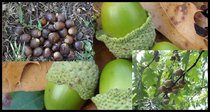
“I didn’t know you could eat acorns!” It pains me to hear this phrase, and I hear it often. It seems that the average person has no idea they are crushing a valuable wild edibles underfoot. Many areas with oak trees are loaded with acorns this year, so it’s proving to be a great year to harvest this wholesome native food.
But what are you supposed to do with them? Here’s an easy method for processing them, and five different ways to eat this humble and ubiquitous tree nut.
Processing acorns starts out by shelling of the nuts and leaching out the tannins that make them bitter and nauseating. You could crack them one by one with pliers or smash them individually with a rock, but the native folks of this land figured out a much better technique: mass breakage.
Simply set out 20-30 acorns on a hard flat surface and smash them all at once with a wide heavy object. Use a sidewalk and a cinderblock in urban environments. Use two big flat rocks in your back yard or in the wild. Whichever “tools” you have at your disposal, you can smash the nuts open in one or two strokes and save yourself a lot of time.
Next, separate out all the shell fragments and place the nut meat pieces in pot of warm water. Soak them in warm water for a few hours, then pour off the water. Do a taste test. If the acorns are still too bitter, soak them in warm water for a few more hours. This water bath leaches out the tannic acid, which causes nausea and digestive distress when consumed. Repeat this until they are palatable.
You could also do a leaching process in moving water with a cloth bag. Clean socks or pillow cases are great, if you have them. Tightly woven baskets are the traditional method of straining them. Immerse the nuts in a running stream and secure them so they don’t wash away. Let the water flow through them for a few days, and you’re ready to move to the next step.
Once the acorns are properly leached, they can be dried a bit to grind into flour, or used while the chunks are still damp.
Roasted Acorns
One of the easiest ways to cook acorns is to roast them. Place the damp nut chunks on a baking sheet and sprinkle with fine salt. Toast them for 15-20 minutes at 375 degrees in a pre-heated oven,
or roll them around in a dry frying pan over the camp fire. You can tell they’re done when the color has changed a little, and the nut pieces smell like roasted nuts. Eat them out of hand just
like peanuts.
Acorn Brittle
For those with a sweet tooth, follow your favorite peanut brittle recipe, and substitute acorns for the peanuts. Use the same volume of acorns that the recipe asks for in peanuts, or add a few
more acorns to make this snack a little more nutritious. Once the brittle is cooled, break it into pieces and enjoy.
Acorn Bread
Dry your leached acorns a little bit. When they are halfway between wet and soft, and dry and rock-hard, run them through a blender, food processor, grain mill, or grind between two rocks. Dry
the resulting acorn meal in a low temp oven for a few minutes, or air dry for a few hours. Then grind it again. This acorn flour can be used to bake breads or almost any other baked good. If
you’re expecting soft spongy bread, blend in some wheat flour for its gluten. It you don’t mind the acorn’s natural crumbly texture, use the acorn flour as-is.
Acorn Cookies
Using the flour described above, try your hand at cookies. You could follow any cookie recipe, swapping out the wheat flour for acorn flour. Since acorn flour is more crumbly than wheat flour,
cookies are a natural fit for this wild food. My favorite are acorn peanut butter cookies. Here’s how to make them:
3 cups of acorn flour
½ teaspoon of baking soda
½ teaspoon of salt
2 eggs
2 teaspoons of vanilla extract
1 cup of white sugar
1 cup of butter
1 cup of brown sugar
1 cup of peanut butter
The butter will cooperate better if it softens up to room temperature before mixing, so set the butter out first. Mix the flour, salt and baking soda in a small bowl, and set it aside. Mix the
softened butter and peanut butter in a large bowl. Add the vanilla and both sugars to the butter mixture, and mix it well. Add the eggs and mix again. Stir the flour mixture into the butter
mixture until smooth. Roll the dough into balls and pat out onto an ungreased baking pan. Bake at 375 degrees for 10 minutes or until lightly brown. Makes 4 to 5 dozen cookies.
Acorn Coffee
This may not seem right to diehard java drinkers since there’s no caffeine in an acorn, but you can roast a coffee substitute from acorns that is pleasant enough to drink. Place chunks of leached
acorn on a cookie sheet and roast them in the oven at 400F for about 30 minutes. This roasting time will depend on the moisture in the nut pieces (more moist acorns need more time). Trust your
eyes and nose when making acorn coffee, and stay right next to the oven. When the pieces are dark brown and give off a roasted (but not a burned) smell, they are done. Add one tablespoon of
roasted acorn to one eight ounce cup of boiling water. Steep for 5-10 minutes, reheat if necessary. Add your normal coffee additives, or drink it “black.”

